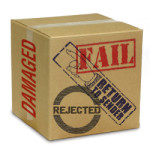Last week, we talked about how to prevent the tragedy of a returned order and what to include in an effective returns policy. But let’s focus on the positive side this time instead – how you can take that returned order experience and give it a total makeover, transforming it into potential revenue that you would otherwise not get.
Hasten to Listen
First thing’s first, listen to your customer and listen well. It’s not only important to seem receptive and caring to the customer (negative experiences will eventually morph into blistering reviews); it’s essential that you take note of what went wrong and understand how to improve. If a product arrived damaged, figure out why. Was it improper packaging or brutal handling by a carrier? If the product was the wrong size or color, was it user error or a complicated, unclear product description? Although it may sound annoyingly cliche, each mistake is an opportunity to improve, and understanding what went wrong is simply step one.
Make the Return of a Return Fabulous
No amount of makeup or pretty fabric can completely reverse the psychological devastation wrought by a returned order. But it can at least make it gorgeous upon its second entrance to the customer! If and when you send back another product to the customer to replace their return, be sure to give it some TLC. Add a thank you note, maybe an apology, or use some custom packaging if you can. The customer may be let down already, so be sure to ‘wow’ them or at least raise an eyebrow as the product struts into their home for the second time.
A Refund of Caution
That said, when it comes to following up on a return, first is the worst, second should be the best, and third is the one where your customer may be a mess. If you’re handling a refund, appeasing the customer is obviously a goal, but there’s a point where it isn’t worth it. If they’re left with some sort of issue after receiving the first order, as well as the second refunded order, you may be spending too much on them. They could be one of those crazy, chronically dissatisfied consumers that are best avoided. Use your own discretion to determine if they’re worthy of your prolonged attention.
Turn That Frown Upsell Down
As a brief definition, upselling is when you persuade customers to purchase additional features, add-ons, or services along with whatever they’re already interested in buying. But, in this situation, offering more products to a customer that recently returned an order seems desperate and inappropriate behavior, especially considering they wanted the product they returned, not something else.
Instead, it’s a good idea to provide some sort of upsell that makes the customer feel reimbursed or looked after in some way.
In the event that a customer is disgusted with the order and refuses to see a new-and-appearance-improved product, offer them a partial discount if possible to cover the cause of the refund. And if you want to avoid having to provide a full refund, whether it’s because you don’t want to pay for shipping or because stock is running low, slide some in-store credit over to them and get them buying again. At the end of the day, you want them browsing your site for products no matter what.
Why
You’re likely wondering how all of this – refunding the product, offering discounts and credit – is supposed to rake in some revenue for you.
The point of all this is to buff the lifetime value of a customer. It’s one thing for a new customer to have a one-off, unfortunate experience due to a return, but another to have that customer leave you forever. In the long run, they may consistently bring in revenue for you, becoming far more valuable than a single customer with a hefty order value. Having excellent customer service in the event of a return is extremely useful for fostering lifetime value, and it definitely helps to get customers typing those credit card digits in for years to come.
Photo: Flickr, Beck Gusler



